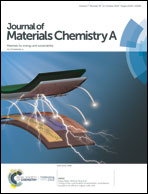Immobilizing an organic electrode material through π–π interaction for high-performance Li-organic batteries†
Abstract
The use of redox-active organic materials in rechargeable batteries has the potential to achieve a high-energy, cheap and sustainable battery. Cuprous tetracyanoquinodimethane (CuTCNQ) is a novel metal organic cathode material with a highly reversible three-electron-transfer reaction, which has been demonstrated with high specific energy density. However, it also faces the challenge of the formation of highly soluble redox products that easily dissolve in the electrolyte and degrade the battery performance during cycling. Herein, a graphene oxide (GO) modified separator (GO separator) is used to immobilize the soluble active materials through π–π interaction between sp2-hybridized carbon rings in GO and aromatic rings in the soluble active material. The CuTCNQ-based Li-ion battery with the GO separator achieves an initial capacity as high as 252.2 mA h g−1 and also shows a significantly improved capacity retention over 100 cycles. Such an effective way to prevent the soluble organic redox materials from moving between the electrodes is applicable not only for Li–organic batteries but also for organic redox flow batteries.



 Please wait while we load your content...
Please wait while we load your content...